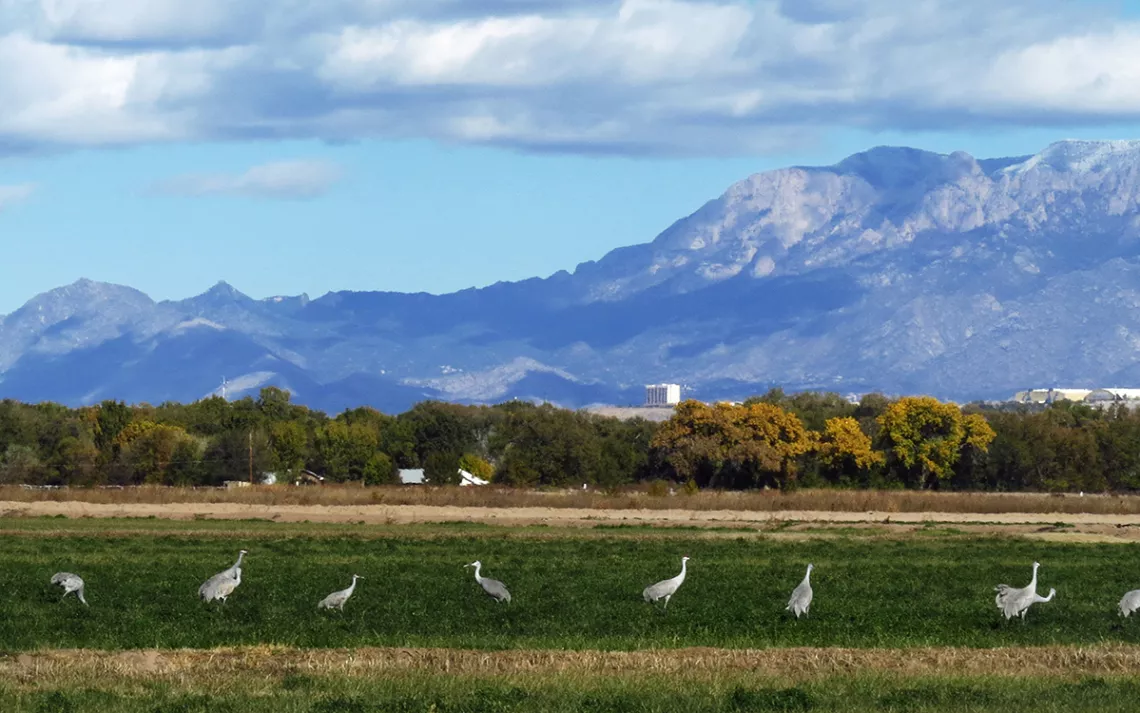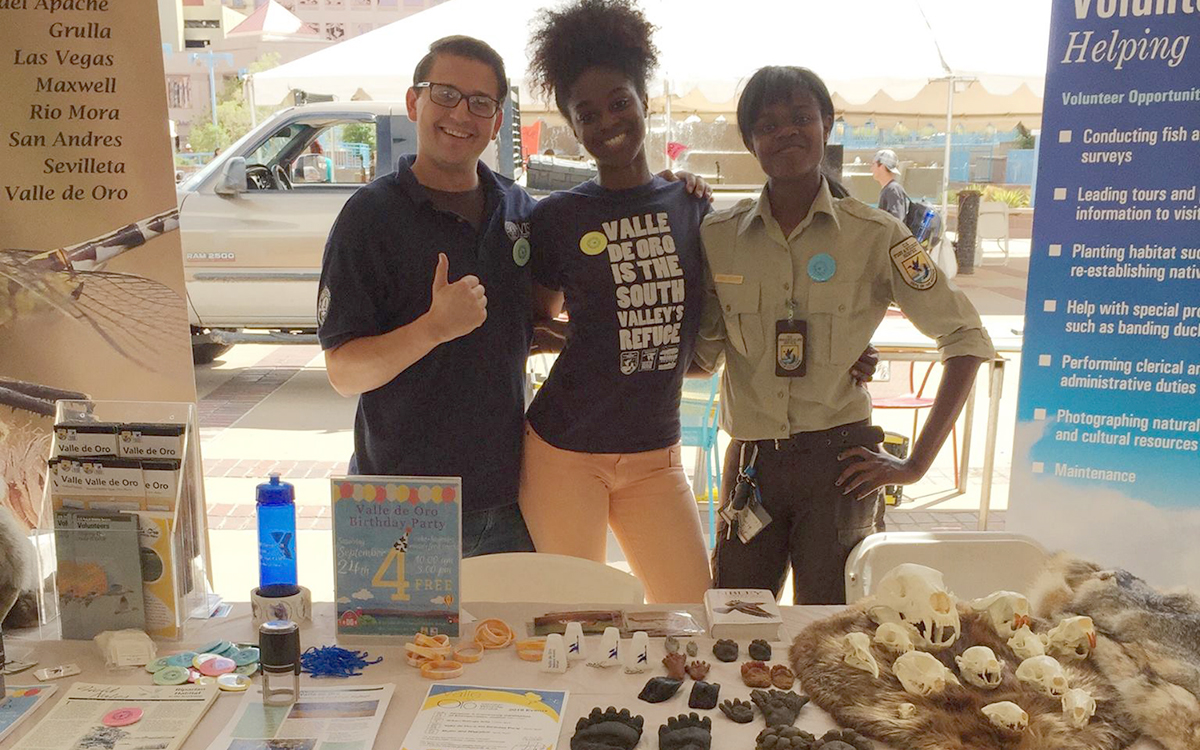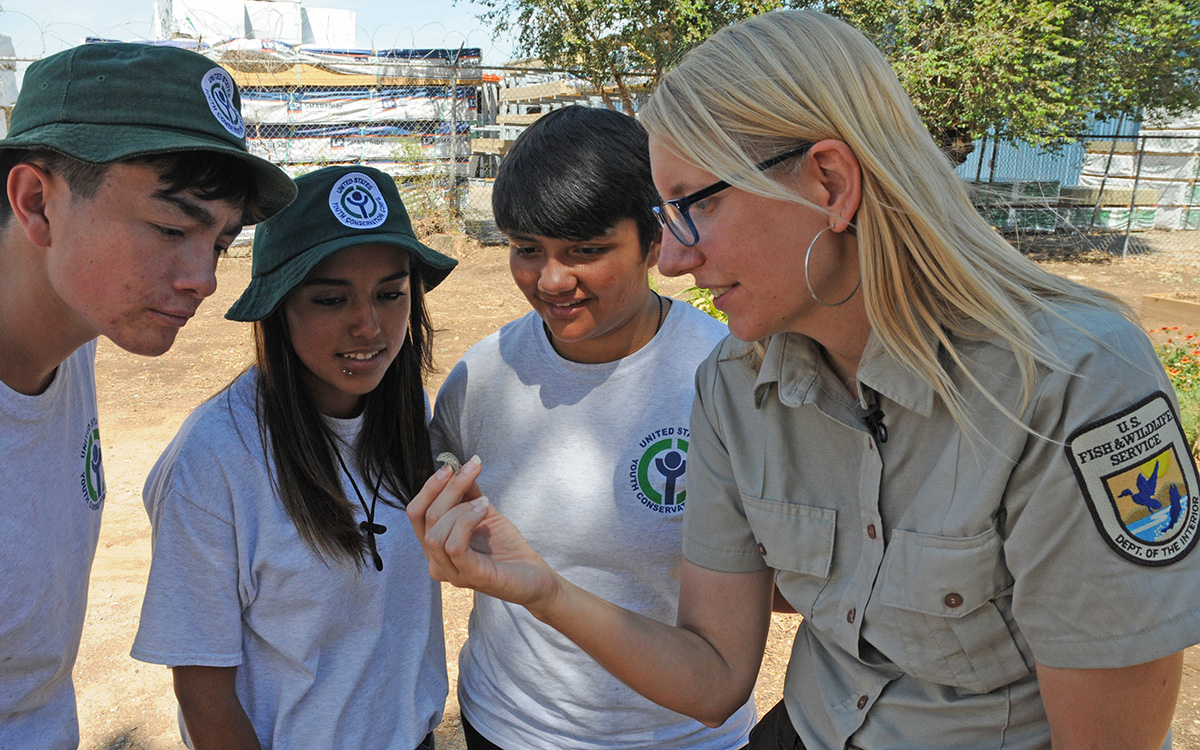How to Prioritize Inclusivity at a Nature Center?
Once-unrepresented groups are shaping one Southwestern wildlife refuge

On a crisp fall evening in Albuquerque, residents from the city’s South Valley Mountain View neighborhood gathered inside a small community center near Valle de Oro National Wildlife Refuge. While Ariel Elliott, a wildlife biologist at Valle de Oro, spoke to a few attendees about plans for vegetation, another small group—local residents chatting among themselves in a mix of Spanish and English—eagerly awaited a chance to connect with the biologist.
A video with Spanish subtitles played in the background as refuge manager Jennifer Owen-White explained that the refuge generally provides snacks for potentially marginalized community members, along with sign language interpretation and Spanish translation. The goal of the community center event—one of three in 2018—was to engage community members in a dialogue about how Valle de Oro will shape itself in coming years.
According to Valle de Oro’s education specialist, Teresa Skiba, who grew up in the community, this kind of neighborhood involvement is unique for a wildlife refuge still in its building phase. The facility is the Southwest’s first urban wildlife refuge. “I think we’ve been really intentional in including our community,” she says.
That night, about 50 community members got the chance to speak with staff.
In recent years, environmental organizations have turned a lens on the lack of diversity in the outdoors and recreational spaces. That attention, however, hasn’t led to true systematic change—US Forest Service data shows that the majority of wilderness visitors in the Southwest are white and that 60 to 70 percent are male.
The refuge’s eight-person staff includes a number of traditionally underrepresented groups, including five women (with one at the helm), one gender-neutral person, seven individuals under 40 years old, and one veteran.
“As a biologist, diversity is always important,” says Elliott, who points out that management has prioritized fielding a diverse staff since Valle de Oro was founded in 2013. The US Fish and Wildlife Service recognized the refuge in 2018 with its Service Environmental Leadership Award for Environmental Justice.
According to staff, those efforts are working—diversity on the front lines, they say, affects the way decisions are being made, which in turn attracts a different crowd, setting Valle de Oro apart from other wildlife refuges.
“We’re getting a lot of young people; we’re getting a lot of people from the neighborhood,” says Owen-White. This slant toward a younger demographic probably has a lot to do with youth outreach done by the refuge—according to the Friends of the Valle de Oro National Wildlife Refuge website, more than 100 youths are employed there each year through programs like Rocky Mountain Youth Corps. And according to the group’s 2016 annual report, 2,460 students were transported to the refuge that year with $14,000 in bus funding.
Owen-White says members of the local community, which is predominately Hispanic/Latino, not only visit the center but are also participants in the development of the relatively young refuge. According to that same annual report, 550 local community members engaged in refuge planning activities that year. This involvement is driven, in part, by Valle de Oro’s ongoing communication efforts within the neighborhood, including door-to-door flyer distribution soliciting participation in decision-making processes and meetings.
 Valle de Oro staffers make a point of participating in community events representing marginalized communities—the refuge regularly has a presence at Albuquerque’s Black Expo and sponsors floats in the annual Dia de los Muertos parade in the South Valley, as well as the Pride parade on Albuquerque’s east side. Staffers also do their best to plan events with intentional inclusivity. Take the above event at the community center—as Elliott explains, staff could have more easily planned an onsite gathering at the refuge but instead chose to go directly into the community it wants to serve.
Valle de Oro staffers make a point of participating in community events representing marginalized communities—the refuge regularly has a presence at Albuquerque’s Black Expo and sponsors floats in the annual Dia de los Muertos parade in the South Valley, as well as the Pride parade on Albuquerque’s east side. Staffers also do their best to plan events with intentional inclusivity. Take the above event at the community center—as Elliott explains, staff could have more easily planned an onsite gathering at the refuge but instead chose to go directly into the community it wants to serve.
According to Owen-White, the refuge’s breadth of projects, programming, and outreach is reflective of its staff diversity. “Diversity is a thread that’s woven into everything we do,” she says. “If we were all the same, we’d only be doing one type of program.”
The idea is to communicate to the public that the refuge has room for everyone, no matter their gender identity, race, beliefs, economic status, or scientific background. “This isn’t just a place for people who wear hiking boots and carry binoculars,” says Owen-White. Multiple staff members echo her sentiment. They say they want the refuge to be a place where visitors can feel comfortable developing their connection with the natural world in the way that best suits them.
Valle de Oro’s home base in Albuquerque’s Mountain View neighborhood is an area that the Environmental Protection Agency classifies as an “environmental justice community.” The refuge represents the first green space in a community dominated by industrial businesses, which are scattered among homes, a school, and a community center. Among other environmental hazards, two of the county’s three Superfund sites are located in Mountain View.
The facility developed a strategic plan outlining its goals for environmental and economic justice for 2017 through 2020. Some priorities include Spanish translation, environmental justice trainings for staff, engagement of communities of color, and encouraging local Mountain View and South Valley community members to apply for positions at the refuge. Action items for the latter goal include hosting career and employment fairs in the community as well as the Pueblo of Isleta, participating in local school career days and publicizing job opportunities at schools and community centers. For their part, Elliott, who identifies as gender-neutral and African American, has led several LGBT and cultural awareness trainings for the staff.
Aside from its community participation and environmental activism, Valle de Oro relies on Facebook to attract diverse groups of people. Owen-White says each employee has a hashtag and “takes over” with a post for #MeOnMonday. The idea is that followers can get to know and connect with staff with whom they identify on a more personal level—whether because of a shared cultural identity, gender, interests, or personality.
Take, for example, administrative officer Melanie Dabovich, a native New Mexican of Hispanic descent, a self-described nature lover, and a fly fisher. She says that thanks to her cultural heritage, she grew up forging a “deep identity with the land” focused on knowledge about when to hunt and how to use certain plants. Dabovich says this land narrative differs from what is traditionally communicated in conservation and adds that she is happy to share her perspective with others. “Letting (visitors) know there are staff that appreciate the land in the same way they do is maybe a breath of fresh air for them.”
Dabovich also works at the nearby Sevilleta National Wildlife Refuge and says she sees a big difference between the visitors who frequent the two facilities. Valle de Oro, she says, attracts more visitors who may not have as much of a background in the outdoors.
Although the refuge has come a long way, Elliott says there is still work to do—in particular, staff intends to introduce more of the African American community to the refuge. Elliott helped start Albuquerque’s chapter of Outdoor Afro with another staff member and says they want their fellow African Americans to know that the refuge is a place for them too. And although it’s a bit of a responsibility, “That type of weight, I don’t mind carrying,” Elliott says, “because who else is going to do it?”

Refuge manager Jennifer Owen-White with a youth crew | Photo courtesy of Valle de Oro
 The Magazine of The Sierra Club
The Magazine of The Sierra Club



